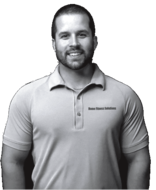Old articles are listed under the tools tab
Mechanically Sound?
Written by: Nathan Baron
It seems nowadays we are becoming more distant from our bodies. We feel a need to seek out invasive medical attention to solve most of our health issues. Of course our medical understanding of the human body is a blessing, but it can also be abused. Do we listen to what our bodies are saying, or do we slap a band aid over it and call it fixed?
The root of most physical problems seems to be that which is most ignored. It is only when we are faced with a problem do we act to fix it. This is something that living in our society has only encouraged; but, herein lies the problem. Now, if we could only seek be more proactive in preventative measures; then we can start to live physically healthy. In addition, when the habitual part of our lives leads us to a point where medical attention is necessary, we often continue with the lifestyle that brought us there to begin with. There is much more to health than our physical being, but for the purposes of this article we will focus on the physical or mechanical part.
Some people do feel more of a disconnect with their bodies. This is where genetics will play its role. Some people are born with vast genetic physical potential. Athletes are the best example– coordinated, fast motor response, and fluidity of movement – others are not. This does not mean that it can’t be learned. Just as your brain has the capacity to learn math or science, so too can it learn movement.
Your body’s physical movements have infinite possibilities. Biomechanically there are proper and improper ways to exploit these movements. In other words, some movements are productive and promote longevity; others are harmful and create damage. This damage occurs in the skeletal and muscular systems, namely, your joints and the muscles that articulate that joint. When a habit is learned and carried out it becomes repetitive, such as hunching at a desk. Since this movement or position is so common and is such an occupying habit of much of our sedentary work force, it is probably the best example to use. When this hunching habit is continued and exaggerated, your normal – neutral – body position is compromised. Unfortunately, there is no default “factory settings” option you can use on your body as there is on a computer. Many of our physical habits are learned, as well as unlearned.
Well, what does it matter that our neutral body position is compromised? When this happens we cease to be efficient with our movements. Our bodies are designed to work optimally when it is in balance with itself or what I refer to as neutral body position. When your body is out of balance inefficiency occurs. You are no longer moving optimally. Joints will not articulate properly, muscles have a skewed strength curve, and other muscle groups are forced to help out these inefficiencies when they would normally be inactive. What this essentially manifests itself as is joint pain, joint wear, strained ligaments and tendons, muscle tears, reduced range of motion, reduced strength, and everything else that inevitably leads to invasive medical attention. The body is one long kinetic chain, so what affects one thing will inevitably affect the other. A great example of this is limping. You limp to alleviate pain on one side. This altered movement pattern puts excess strain and wear on the stronger side. This possibly leads to damage on the strong side, leaving both sides incapacitated. These imbalances or inefficiencies continually feed off of each successive imbalance, thus affecting the whole body. So yes, as you were told as a kid to “stand up straight and have good posture”, there is an essential purpose to it.
What does this mean for you? Well, start with the areas that are giving you complications or pain. Do your knees hurt? If they do, the movement they have habitually learned is inefficient. Same goes for your shoulders, back, or hips. You need to unlearn what you have learned. The way you do this is to simply reinforce and learn new habits. Actually, this is quite simple to see when you look at your body. Your front profile should show two parallel lines formed by your ankles, knees, hips and shoulders. Your side profile should show 1 straight line going through the midpoint of your ankles, knees, hips, shoulders, neck, and head. Is your head far forward from your shoulders? Are your shoulders pointed forward? Do your toes point out excessively? Do your knees bow? When you walk do you just bend at the knees and not at the hips? These are some common questions to review to make proper corrections to your posture. So, sit up straight at your desk. Don’t trudge along when you walk; walk tall and take full strides. To take a more aggressive approach to bringing your body back into balance make sure you reinforce proper body mechanics during exercise. As a side note, this is where a fitness professional is going to help you most. The most important thing with developing continuity in an exercise plan is to make sure you are “able” to keep moving. To make sure you are able and you’re doing what you can to be progressive with your physical health, being conscious of your body’s position and how you use it is imperative.
Home Fitness Solutions
Keeping fitness simple by bringing it to your home!

